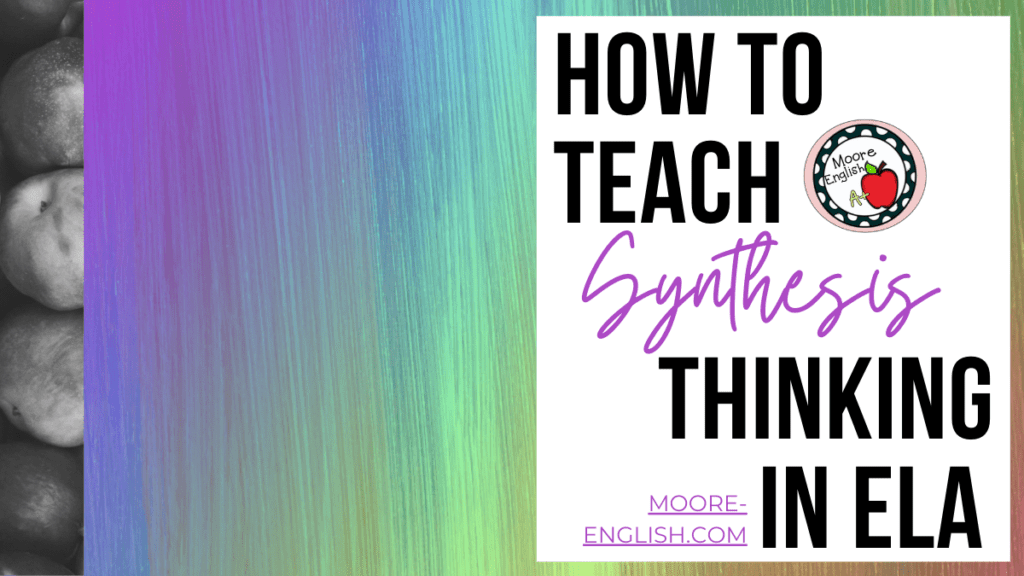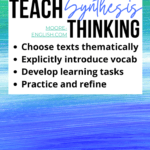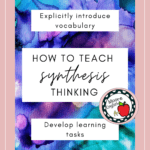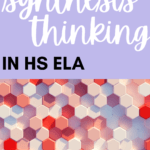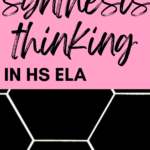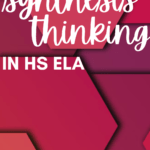Over the course of a school year, one of my goals is to move my sophomores toward synthesis thinking. CCSS.ELA.R.7 and R.9 require synthesis thinking. Bloom’s Taxonomy also moves students toward synthesis as a means of achieving creation. As we enter second semester, it’s about time for my students to begin making the move from analysis to synthesis. Here’s how I know students are ready to make the move:
- First, their writing is well organized. Students can structure a paragraph with very little scaffolding.
- Second, their writing is logical. Students provide appropriate background information and context.
- Third, their writing embeds and cites evidence smoothly. Students select evidence that supports their claims, embed evidence smoothly, and cite it correctly.
- Fourth, their writing is insightful and relevant. Students follow evidence with analysis that demonstrates the significance of the main idea.
Now, I have an awesome English I team that helps students focus on these four aspects of writing. This means that when students come to me as sophomores, they have a strong foundation in analytical thought. After a semester, we’re usually ready to move into synthesis thinking. And that’s what we’re talking about today.
This post this post may contain affiliate links. Please read the Terms of Use.
Choose Texts Thematically
In preparing to introduce students to synthesis thinking, it’s important to carefully select texts that touch on complementary subjects or topics. Here are some ideas for choosing texts that lend themselves to synthesis:
First, look for a shared symbol.
- For example, the poems “To Kill a Deer” by Carol Frost, “Deer Hunt” by Judson Jerome, and “Traveling through the Dark” by William Stafford all feature a common symbol. Because the deer symbol is concrete (and because I have a lot of students that look forward to hunting season), this text collection is a great place to begin.
- In addition to hunting, my students love basketball, so this collection of texts about basketball is a good opportunity for students to practice synthesizing, focusing on a shared symbol, setting, and love. The texts “Slam, Dunk, & Hook” by Yusef Komunyakaa, “Home Court” by Jose Olivarez, and “Privileged” by Kyle Korver allow students to practice synthesizing across genres and mediums.
Secondly, look for a similar subject or theme.
- First, poems about love are so common that they make a great place to start. Among my favorite love poems are “Old Love” by Pat Mora (read it here), “Senior Discount” by Ali Liebegott (read it here), and “Long Distance II” by Tony Harrison (read it here). Of course, Shakespeare’s sonnets are also a great choice! All my favorite love poems are in this synthesis bundle!
- Additionally, “T.S.A.” by Amit Majmudar and “Gate A-4” by Naomi Shihab Nye share similar settings while providing commentary on racism, stereotyping, and racial profiling. These are texts that really cause my students to engage in powerful discussion. Check out my resources for teaching these two texts.
- Similarly, “To Live is an Act of Courage” by Jennifer Michael Hecht, “Courage” by Anne Sexton, and “Invictus” by William Ernest Henley all focus on courage. While these texts are wildly different, their shared themes make them ideal texts for synthesis. Plus, with this text collection, students can also practice synthesizing across genres and mediums.
Thirdly, look for a shared historical or cultural perspective.
- For example, “Complaint of El Río Grande” by Richard Blanco (read it here) and “Zapotec Crossers (or, Haiku I Write Post-PTSD Nightmares)” by Alan Pelanez (read it here) share a similar historical context and symbol. These are tough, moving poems; nevertheless, they provide students with a rich subject for synthesis.
- Additionally, one of my favorite happy accidents in British literature is the naming of Cathy Moreland in Northanger Abbey and Cathy Earnshaw in Wuthering Heights. Reading excerpts from these passages alongside one another is a great way to synthesize within an historical period.
- Finally, “Sympathy” by Paul Laurence Dunbar (read it here) and “Caged Bird” by Maya Angelou (read it here) share a common symbol and cultural perspective. While these poems were written lifetimes apart, they also make clear how heavily racism and white supremacy affect the US.
Fourthly, consider an in-depth author study to track an idea and its development across multiple texts.
- For example, Emily Dickinson’s poetry is full of her ideas about life and death. My favorite Dickinson poems are included in this 3-resource bundle. Like Dickinson, Edwin Arlington Robinson’s characters explore pain in all its forms. My students are always engaged in our classroom study of his most-famous works.
- Similarly, Gerard Manley Hopkins explores complementary ideas in his poems “God’s Grandeur” and “Spring and Fall: to a Young Child.” Reading these poems side by side offers students the opportunity to synthesize ideas about nature, divinity, and humanity. Like Hopkins, William Cullen Bryant often explores the nature of the universe in his poetry.
- Additionally, Ralph Waldo Emerson is famous for fleshing out the theories of Transcendentalism across his life and in his literature. Reading excerpts from “Nature” and “Self-Reliance” helps students see an author working through the same thought processes they are working on.
Explicitly Introduce Synthesis
“Synthesis” is a tier-two vocabulary term. In different contents, the definition may vary. However, at its core, synthesis is always about creation regardless of content area. Students draw on a variety of sources and ideas to arrive at a new understanding.
To help students approach synthesis, I begin with some inquiry-based learning.
- First, I tell students we’re preparing to make the move from analytical writing to synthesis writing.
- Removing the labels, I show students this image that I found on Pinterest. Then, I ask students to think-pair-share to decide which image represents analysis and which represents synthesis.
- Next, I explicitly define the term “synthesis” before referencing the texts we have been reading. I model synthesis thinking with information from the texts we have been reading, often providing students with an example main idea or theme statement that I could only develop having read multiple texts.
- Depending on the amount of time we have, I might also show students an example of synthesis writing.
Develop Synthesis-Style Prompts
When approaching synthesis writing, students often want to compare and contrast texts. While compare/contrast may be a great way to begin analysis, synthesis resists purely binary thinking. For teachers, this means designing prompts that do not lend themselves purely to compare/contrast-style thinking. Here are some stems to help design synthesis-style writing prompts:
- What is the relationship between x and y?
- How would the authors/characters/speakers define x?
- Based on the texts, what would be the best approach for x?
- What solutions would you offer to the author/character/speakers?
- Having read the texts, what does successful x look like? What does failure look like?
Practice and Refine with Feedback
Because synthesis requires a different lens, students do not magically arrive at synthesis thinking or writing on the first try. Instead, synthesis, like most skills, requires cycles of practice and feedback.
It’s also important to note that synthesis and analysis are closely related. They complement one another. Before students can successfully synthesizes across texts, they must also be able to analyze texts. Analysis feeds synthesis, and synthesis leads to new analysis.
Working across different media is another great way to practice synthesis and analysis. CCSS.ELA.RL.7 explicitly challenges students to work across media and formats. Of course, teachers often practice this with film representations of literary works, but artwork can also be a great tool to help students synthesize.
Here are some options for visualizing synthesis:
- Artwork is a great opportunity for synthesis thinking. I’ve worked hard to compile famous pieces of artwork to accompany some of Shakespeare’s most-famous plays. Check out these resources for Visualizing Shakespeare!
- Secondly, “Mercy” by Rudy Francisco and “Allowables” by Nikki Giovanni share a similar subject and symbol. The context of these poems is so relevant, and the commentary on racism is so powerful. I cannot recommend these poems enough. Reading these poems alongside informational texts, news clippings, or artwork can help students appreciate the systemic nature of institutionalized racism. Check out my resources for helping students read and synthesize these texts.
- Similarly, “lady liberty” by Tato Laviera, “The New Colossus” by Emma Lazarus, and “Three Liberties: Past, Present, Yet to Come” by Julia Alvarez all focus on the Statue of Liberty. Reading these texts alongside propaganda about immigration is a good way to help students synthesize across mediums. With this text collection, students work on synthesizing abstract ideas about freedom.
How do you help your students work on synthesis thinking? Let us know in the comments!



